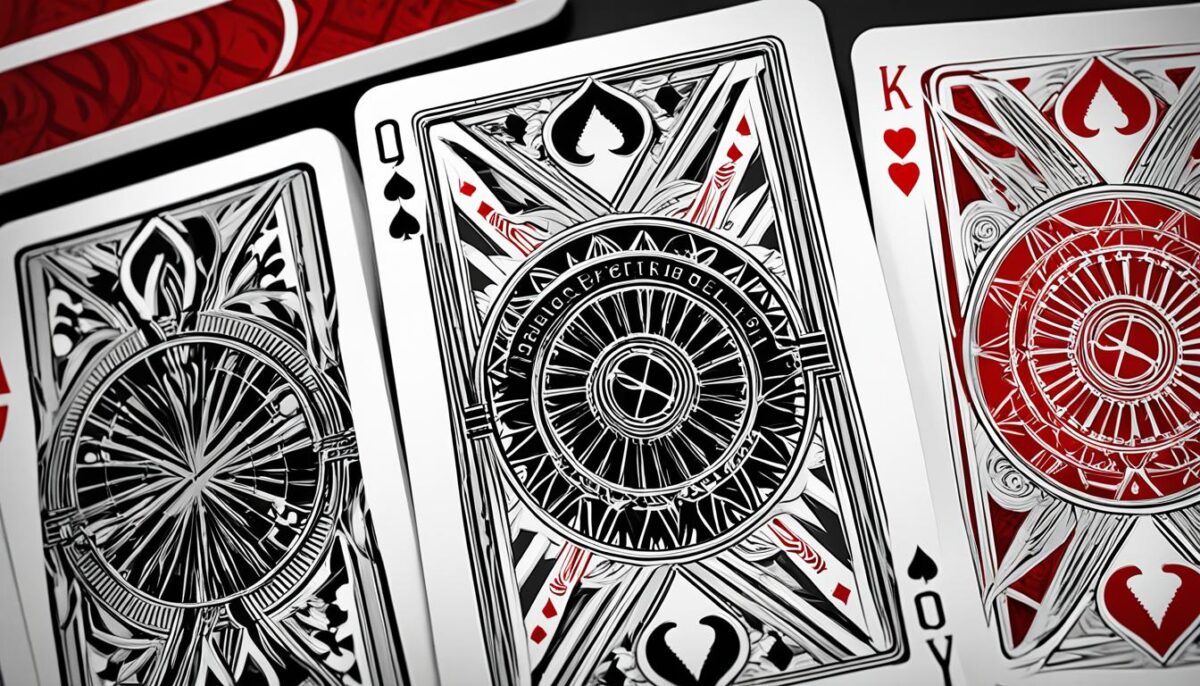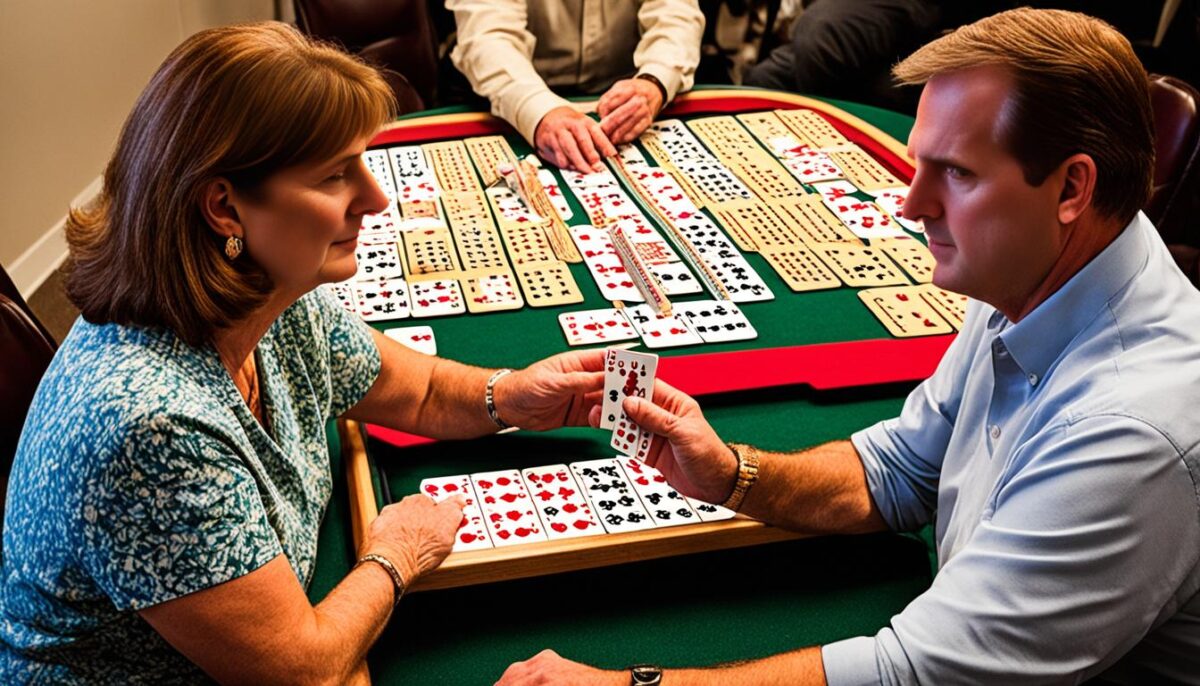Welcome to Bridgepoint Playing Cards, your go-to source for premium quality playing cards that combine durability, captivating design, and endless entertainment. Whether you’re a seasoned card game enthusiast or simply looking to elevate your game nights, Bridgepoint Playing Cards are the perfect choice for you.
Our playing cards are meticulously crafted with the utmost attention to detail, ensuring a superior gaming experience every time. With their unrivaled durability, these cards can withstand countless shuffles, making them a long-lasting investment for any game night.
But it’s not just about durability; Bridgepoint Playing Cards also boast stunning design elements that add a touch of elegance to any card game. From the intricate patterns to the vibrant colors, every card is a work of art that will inspire awe among your fellow players.
Whether you’re hosting a casual family gathering or a competitive game night with friends, Bridgepoint Playing Cards will take your card games to the next level. Their premium quality guaranteed to enhance the excitement and bring endless entertainment to your gaming sessions.
The Fusion of Durability and Design
When it comes to playing cards, finding the perfect balance between durability and design is essential. Bridgepoint Playing Cards seamlessly fuse these two crucial elements, creating a card set that stands out from the rest.
One of the standout features of Bridgepoint Playing Cards is their exceptional durability. Made from high-quality materials, these cards are built to withstand countless hours of gameplay without showing signs of wear and tear. The sturdy construction ensures that these cards can withstand repeated shuffling, dealing, and handling, making them a reliable choice for both casual and professional card players.
But it’s not just about durability; Bridgepoint Playing Cards also excel in their design. The attention to detail in the artwork and aesthetics is evident, elevating these cards to a whole new level. Whether it’s the intricate patterns, vibrant colors, or unique illustrations, the design of Bridgepoint Playing Cards adds an extra layer of visual appeal to every game.
By combining durability and design, Bridgepoint Playing Cards offer the best of both worlds. Players can enjoy extended gameplay sessions without worrying about their cards wearing out, all while enjoying the stunning visuals that enhance the overall gaming experience.
The fusion of durability and design is what sets Bridgepoint Playing Cards apart from the competition. With these cards, players no longer have to compromise between functionality and aesthetics. They can have a reliable and long-lasting card set that looks visually stunning and adds excitement to any game night.
So why settle for ordinary playing cards when you can elevate your gameplay with Bridgepoint? Discover the durability and design fusion for yourself and take your card games to new heights.
Elevate Your Card Games
When it comes to card games, the right playing cards can make all the difference. That’s where Bridgepoint Playing Cards come in. These premium quality cards are specifically designed to elevate your card games and take your entertainment to the next level.
With Bridgepoint Playing Cards, you can expect a truly immersive gaming experience. The superior craftsmanship and attention to detail ensure that each card is durable and long-lasting, allowing you to enjoy countless game nights without worrying about wear and tear.
But it’s not just about durability. Bridgepoint Playing Cards also feature stunning designs that add a touch of elegance and sophistication to any gaming session. Whether you’re playing poker, blackjack, or any other card game, these beautifully crafted cards will enhance the visual appeal of your gameplay.
But what truly sets Bridgepoint Playing Cards apart is the way they elevate the overall entertainment factor of your card games. The smooth card handling and precise printing make each shuffle, deal, and play a seamless experience, adding an extra layer of enjoyment to every game.
“Playing card games with Bridgepoint Playing Cards is like stepping into a world of luxury and excitement. The high-quality materials, exquisite design, and smooth gameplay truly elevate the entertainment value.” – Mark Thompson, avid card game enthusiast
Whether you’re hosting a game night with friends or spending a relaxing evening with family, Bridgepoint Playing Cards are the perfect choice for enhancing your card games. These cards bring a new level of sophistication and entertainment, ensuring that every game is memorable and enjoyable.
So why settle for ordinary playing cards when you can elevate your gaming experience with Bridgepoint Playing Cards? Discover the joy of playing with premium quality cards that not only elevate your card games but also elevate your entertainment as a whole.
The Perfect Choice for Every Game Night
Bridgepoint Playing Cards are the ideal companion for your game nights, offering a premium quality gaming experience that is unmatched. With their exceptional craftsmanship and attention to detail, these cards elevate your card games to a whole new level of excitement and enjoyment.
Designed with the utmost care and precision, Bridgepoint Playing Cards ensure durability and longevity, allowing you to enjoy countless game nights without worrying about wear and tear. The cards are made from high-quality materials that guarantee their resilience, making them a reliable choice for avid card game enthusiasts.

Not only are Bridgepoint Playing Cards durable, but they also feature a stunning design that adds a touch of elegance to any game night. The intricate artwork and captivating patterns on each card enhance the visual appeal, creating a truly immersive gaming experience.
“These cards are truly exceptional. The quality and design are top-notch, making them my go-to choice for game nights with friends and family.” – Sarah Thompson, avid card game enthusiast
One of the remarkable aspects of Bridgepoint Playing Cards is their versatility. Whether you are playing poker, blackjack, or any other card game, these premium cards adapt to any gameplay situation seamlessly. The smooth handling and comfortable feel of the cards contribute to a pleasurable gaming experience for both beginners and seasoned players.
No game night is complete without Bridgepoint Playing Cards. Their premium quality, superior design, and adaptability make them the perfect choice for all types of card games. Elevate the entertainment and enjoyment of your game nights by choosing Bridgepoint Playing Cards.
Experience the Bridgepoint Difference
Key features of Bridgepoint Playing Cards:
- Premium quality materials for enhanced durability
- Stunning designs that capture attention
- Smooth handling for optimal gameplay
- Versatility to adapt to various card games
| Bridgepoint Playing Cards | Other Playing Cards |
|---|---|
| Premium quality | Inferior materials |
| Intricate design | Generic artwork |
| Superior durability | Prone to wear and tear |
| Smooth handling | Inconsistent performance |
Where to Find Bridgepoint Playing Cards
If you’re looking to get your hands on a deck of Bridgepoint Playing Cards, you’re in luck! These premium quality cards are readily available both online and through various retailers.
Online Retailers
One of the easiest and most convenient ways to purchase Bridgepoint Playing Cards is through online retailers. These platforms offer a wide selection of card decks, including Bridgepoint, and provide a seamless shopping experience. Some popular online retailers where you can find Bridgepoint Playing Cards include:
- Amazon
- eBay
- Walmart
- Target
When purchasing from online retailers, make sure to read customer reviews and check the seller’s reputation to ensure a reliable and trustworthy transaction.
Physical Retailers
If you prefer a more hands-on shopping experience or want to support local businesses, you can also find Bridgepoint Playing Cards at select physical retailers. These include gaming stores, specialty card shops, and hobby stores. Here are a few examples of physical retailers that stock Bridgepoint Playing Cards:
- GameStop
- Barnes & Noble
- Card Kingdom
- Local game and hobby stores in your area
It’s always best to call ahead or check the store’s website to confirm availability before making a trip.
Whether you choose to shop online or visit a physical store, you’ll have no trouble finding Bridgepoint Playing Cards. Just remember to compare prices and always look for authorized sellers to ensure you’re getting an authentic deck of these exceptional playing cards.
Conclusion
Bridgepoint Playing Cards offer an exceptional blend of premium quality, durability, and captivating design for an unforgettable game night experience. With their sturdy construction and long-lasting materials, these cards are built to withstand countless rounds of gameplay without compromising their elegance and style.
Throughout this article, we have explored the fusion of durability and design that sets Bridgepoint Playing Cards apart from the rest. Their attention to detail in the intricate design not only enhances the aesthetic appeal but also adds a touch of sophistication to any card game.
Whether you’re a casual player or a devoted card enthusiast, choosing Bridgepoint Playing Cards is the perfect choice to elevate your card game. These high-quality cards are crafted with precision to bring more excitement, entertainment, and enjoyment to your game nights.
In summary, Bridgepoint Playing Cards provide the ideal combination of premium quality, durability, and captivating design. With their ability to enhance the overall gaming experience and their availability through various online and physical retailers, Bridgepoint Playing Cards should be your top choice for your next card game gathering. Make your game nights truly remarkable with Bridgepoint Playing Cards!



